KOREA: THE FORGOTTEN WAR - 1/48 Hasegawa F-86E-5(Can) – Major John Bolt, USMC
The Airplane:
The F-86 Sabre was the first really successful US jet fighter, with 9,800 Sabres produced between 1949-60 in the U.S., Canada, Japan, Italy and Australia.
The F-86A was capable of supersonic flight in a dive, though the airplane was actually out of control, flying beyond its critical mach number, when it accomplished that feat. It was only due to the fact that by chance (since the aerodynamic rules of supersonic flight were unknown at the time of the F-86's initial design) the horizontal stabilizers were located at the right position on the fuselage below the vertical stabilizer, but high enough not to be blanked by vortices from the wing, while also being large enough not to be blanked by the supersonic shock wave off the nose, that the pilot could maintain enough control not to crash in a supersonic dive.
The F-86E solved the problems of the F-86A by adopting the “all-flying tail” that was developed during the X-1 supersonic flight program. The entire horizontal stabilizer moved as an elevator, with the elevator moving as a control tab at higher speeds, thus maintaining controlled flight through Mach 1. This system was so successful that when the Soviets recovered Bud Mahurin's crashed F-86E from North Korea in 1952 and transported it to the USSR for study, the North American designed all-flying tail was adopted for all Soviet supersonic fighters and can be found on Russian aircraft to this day. The Soviets also copied the F-86E's ASP-4N optical gunsight and the SRC-3 radar-ranging gear used by the gunsight, using it on the MiG-17. The all-flying tail used full power-operated controls with an "artificial feel" built in to give the pilot forces on the stick that were still conventional, but light enough for superior combat control. This improved high-speed maneuverability, allowing Sabres to initiate supersonic dive attacks (on the rare times when the F-86 found itself flying higher than the MiG-15).
In 1951, the need for Sabres in Korea became so critical that the Air Force ordered 60 Sabres from Canadair, which were delivered as the F-86E-5 (Can), a designation later changed to F-86E-6. All the Canadair-built Sabres were sent to Korea, where they formed the initial equipment of the 51st Fighter Interceptor Wing when the unit converted from the F-80 to the F-86. North American F-86Es replaced the F-86As in the 4th FIW. Interestingly, the Canadair-built Sabres were considered technically superior to the North American product.
While the F-86F that arrived in Korea beginning in the fall of 1952 soon changed the slatted wing for a “solid” leading edge known as the “6-3" wing for the change in the leading edge that increased chord and gave the Sabre the ability to fly and fight at higher altitudes than before, the slatted-wing F-86Es were still around in the spring of 1953 when the Rules of Engagement were loosened to allow “hot pursuit” of MiGs north of the Yalu (which had been happening unofficially and against the rules since 1951), as the MiG Alley air war heated up in the final months of the war.
Major John F. Bolt, USMC Sabre Ace:
Throughout the Korean War, Navy and Marine pilots, along with RAF pilots, served in the two Sabre wings. In fact, Navy Lt. Commander Paul Pugh came so close to embarrassing the Air Force by becoming the first “MiG Ace” in 1951 that he was removed from operations after scoring his third victory, to insure that an Air Force pilot gained that honor.
In 1952-53, the 51st FIW welcomed Marine pilots to gain Sabre experience as the Marines were about to receive the FJ-2 Sabre. Several Marine pilots gained single victories, with two being credited with 2 victories that spring.
Major John F. Bolt, a World War II ace with six victories scored in the Solomons with VMF-214 “Black Sheep,” arrived in the 51st wing in March 1953, following completion of his Marine combat tour where he flew 94 missions in F9F Panthers with VMF-115. Bolt had previously served an exchange tour with the USAF 318th FIS, where he converted to the F-86. He joined the 39th FIS flight led by Joe McConnell, starting as Number 4 flying wing to McConnell after RAF Flight Lieutenant Roy French, McConnell's previous wingman, completed his tour. Bolt moved up to element lead Number 3 in late April. After McConnell left for his “ace tour” at the end of May, Bolt took command of the flight.
Bolt finally met MiGs on May 16, 1953, on his 17th mission into MiG Alley. The flight crossed the Yalu and was attacked by MiGs at 45,000 feet; Bolt quickly found himself with a MiG on his tail. He managed to evade and latched onto another MiG; opening fire, he hit the enemy fighter in the engine; it caught fire and the pilot ejected.
Six days later on May 22, the flight was again north of the Yalu and came under attack from MiGs. Outmaneuvering the MiG on his tail again, he spotted another attacking his wingman and chased it to 7,000 feet, shooting it down near the Yalu.
A month later, flying his 31st mission on June 24, he caught a single MiG north of the Yalu and shot it down after a brief fight. A week later, north of the Yalu again on June 30, Bolt spotted and quickly shot down another MiG; his score was now four victories and two "damaged."
On July 11, Bolt flew his 37th mission, leading his flight across the Yalu above Sinuiju.The second element departed early due to low fuel; Bolt and his wingman remained and soon spotted four MiGs taking off from Antung air base. Bolt dived on them as they lifted off the runway and shot down the leader over the field with four bursts, the MiG crashing and exploding just beyond the runway. He turned on the leader's wingman and scored hits on the fuselage, forcing the enemy pilot to eject. The two Sabres then fled across the Yalu back into MiG Alley.
With a final score of six, Major John F. Bolt became the only non-USAF MiG Ace of the Korean War, the only USMC jet ace, and the only Naval Aviator to become an ace in two wars. He was awarded the Navy Cross for the feat, and returned to the United States at the end of the month.
The Kit:
Hasegawa released their kit of an F-86F-30 Sabre in 1996. The kit was released several times in limited releases for Korean War aces, RAF and RCAF Sabres, and was updated with an extended wing and released as a JASDF F-86F-40 in two releases, the last a limited release in Blue Impulse flight team markings. The kit is not in production at this time, but the various releases can be found with eBay vendors, with prices ranging from $40-$65, depending on the rarity of the release. This past May, several kits showed up at my LHS estate sale at $30 each and quickly found a home here at Le Chateau du Chat.
I don't know why no company has released a kit of an F-86A or F-86E with slatted wings; from comments by modelers over the years, it would seem to be “a license to print money.” Cutting Edge released an F-86A conversion set in 2003, with a resin leading edge and slats, and different rear fuselage, and then an F-86E conversion set. Bill Scobie released a “narrow chord” slatted F-86E wing for the F-86A and E, and a “6-3" slatted wing for the Sabre Mk. 6, back in 2009; these "drop fit" conversions were available for about two years.
Gary Byk at Red Roo Models bought the Scobie wings, and has released the narrow-chord slatted wing occasionally since 2019. He produces ten at a time, and makes new ones approximately every two years. When he did the last batch, I picked up the last two.
I had purchased the Warbirds Decals F-86 sheet 48026 a couple years ago, to do John Glenn's “MiG Mad Marine.” The sheet also has John Bolt's F-86E “Darling Dottie.” When I managed to snag the Red Roo slatted wings and score the five Sabre kits at the LHS, I decided I would do Bolt's “Darling Dottie.”
Construction:
Hasegawa's Sabre kit really benefits from a resin cockpit, or at least a resin ejection seat. That big clear canopy lets you see a lot, once the model is built. When I got the kits at the LHS, I also went up to eBay and bought two OOP True Details F-86 cockpit and three Quickboost sets, since these sets have seats with molded-on belts and other extra detail. I assembled and painted one and installed it in the fuselage of this kit.
The F-86E wing has a narrower chord than the 6-3 wing that is in the kit. The Red Roo wing is drop-fit, but you have to fill in an area of about 1/8 inch at the forward end of the wing cutout area of the fuselage. I used Evergreen sheet for this. I had to fill that with Mr. Surfacer and sand the area smooth, then rescribe detail.
I decided to close the canopy on this model, since it is big and clear and one can see the cockpit detail as clearly as when the canopy is posed open.
Once assembled, it was time to paint the model.
Painting:
I applied a primer coat of Tamiya X-18 “Semi-Gloss Black,” misted on to give a mirror finish.
I then applied a “base coat” of Vallejo “Aluminum” and allowed it to cure overnight. I then masked off the central section of the wings and painted those areas with Vallejo “White Aluminum” with a dollop of Tamiya Gloss White to give a more grayed-out color.
I brush painted the other smaller panels with Vallejo “Semi-Matte Aluminum” and “Dull Aluminum,” and painted the gun blast covers with Vallejo “Duraluminum.” The nose cap of an F-86 is silver plastic, which I created with Vallejo “White Aluminum.”
Decals:
I used the Warbirds Decals 48027 “Sabre Markings” for the yellow ID stripes and stenciling, and the 48026 sheet for the specific markings for “Darling Dottie.”
Final Assembly:
I attached the wing slats and the landing gear, and called it done.
Overall:
If you haven't figured it out long ago, my two favorite jets are the F-86 Sabre and the F9F Panther. The opportunity to grab these five kits, and decals for Darling Dottie and some foreign Sabres, means I will finally have a collection ranging from the F-86A through the FJ-3, all sub-types and the major air forces the type flew with. If you want a slatted Sabre, since the model companies seem resolute in their desire not to make money, keep track of Red Roo Models website, and grab the wings when Gary releases them. You might leave him a comment requesting them, which could speed the next batch.
Review kit and conversion items courtesy of all you book buyers.
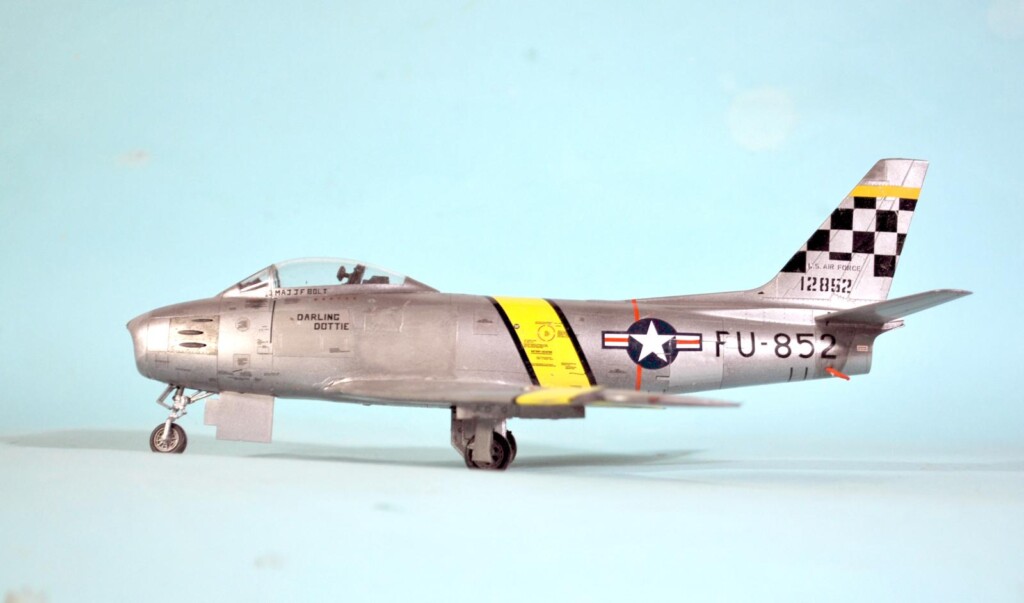
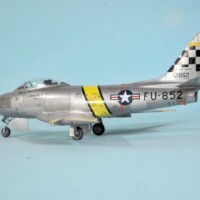
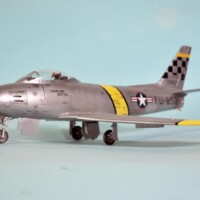
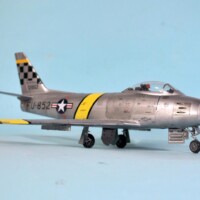
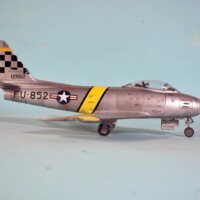
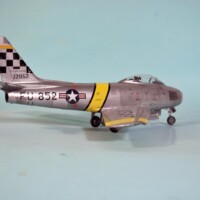
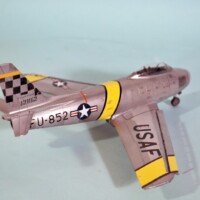
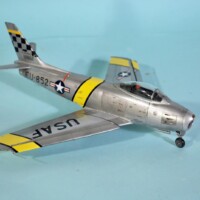
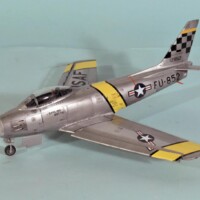
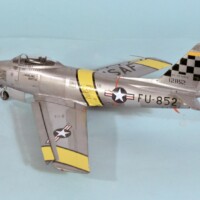
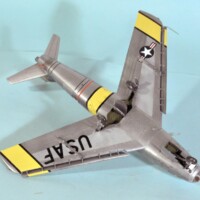
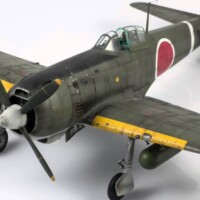
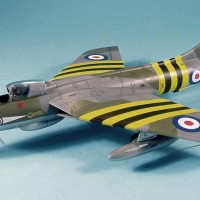
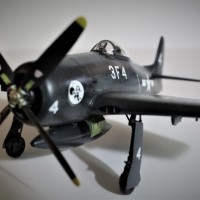
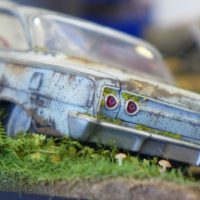
A true metal beauty! Different and subtle shades of metal, lovely. I could never do it that clean.
Very convincing Tom
Thanks for the slatted tip.
Nicely done, Tom. Like the NMF paint job.
Excellent result and ditto article, Tom!
Sabres are so cool and don't get enough attention. Great work on the NMF and as always, your background is a great education.
Great build and finish, and my history lesson for the day!
Great story as usual Tom, coupled with a beautiful NMF scheme
Tom Cleaver (@tcinla)
I met and talked with John Bolt once, many years ago. He lived nearby. Now I wish I had the opportunity to have had many more conversations with him.
Your Sabre jet looks great, and I will keep this information about the differences in mind for future Korean War era models.
Great looking Sabre Tom. Those Vallejo metal line paints do give a realistic NMF finish and they're easy to use.
They certainly are! And there's no stench. 🙂
Absolutely amazing result, Tom @tcinla
I'm definitely going to use yours as an example for the F86F from Academy kit which I recently received from Spiros @fiveten in the same scheme.
Looks great, Tom. The metal panel variations look amazing, really nice Sabre!
Just simply amazing. Been putting glue to plastic for over 50 years and have never built an F-86. May have to change that.l and if it turns out half as good as yours, I'll be happy.
The Hasegawa kit is generally fairly available on eBay, and I was amazed to find the "limited releases" they have done that I didn't realize had shown up.
Thanks Tom for the info. Will have to go looking on eBay. Right now going to look up all your reviews, so I know what to expect.
Great article Tom and very impressive model. The natural metal finish is excellent.
Lovely Tom. Every time I read about someone slamming Vallejo Metallic I always have a good laugh
They have obviously never even seen it if they are.
Very nice early jet.
Really nice work on this Tom , I always loved the look of the Sabre. I have the Airfix Canadair kit in my stash any idea what it builds up like ?
So did RAF pilots and US pilots fly along side each other in the same squadron in Korea ?
The Airfix Sabre looks OK(ish). For some reason it doesn't come across to me as the equal of the rest of "new Airfix." The F-40 wing limits your possibilities markings-wise.
RAF pilots were members of US squadrons. My friend the late Roy French was a Flight Lieutenant when he got set to Korea in 1952 and ended up as Joe McConnell's wingman. McConnell was wearing Roy's helmet (which had RAF roundels over the "ears") when he got shot down in that famous dogfight - he lost the helmet when he went into the Sea of Japan after punching out. Johnny Johnson also flew a tour as a "visiting fireman" as did WW2 leading Typhoon ace John Baldwin. Around 80-100 RAF pilots flew with US squadrons to give the RAF a cadre of combat-experienced jet pilots.
Great write up and build Tom 👍
Excellent background story on aircraft, pilot and build!
Thanks for sharing.
BTW the build itself is outstanding as well … 🙂
great work tom @tcinla nice looking model and in depth historical insight some key facts thank you
Well done Tom, nice article as well.
Nice work, Tom. I’ll definitely keep my eyes open for that Red Roo set. I have one Hasegawa kit remaining in the stash. I’m still surprised that Airfix tooled new 1/48 Sabres, but neglected to do an “E” model.
Me too.
Beautiful work, and thanks for sharing the story behind this model. I really don't know much about that period and it was very educational
That really came out nice, TC @tcinla. Great story as well. I don't know why there are so many negative comments about Vallejo metal paints. They certainly work well for me. Your paint job shows it too.
Well done, Tom (@tcinla). This conversion, along with the NMF, really came out well. At one point, along time ago, it seemed like every model manufacturer had at least one F-86 of some type in their inventory. Now you have to search Ebay to find them. Times really change.
Great build and finish, I love the F-86. Plus another great read.
Mighty nice work, Tom @tcinla! 👍 Your NMF here is selling me on the Vallejo paints; with SNJ and Floquil Silvers no longer around, they seem like a great choice for bare metal jobs.
A beautiful Sabre, and as usual a nice thorough article!